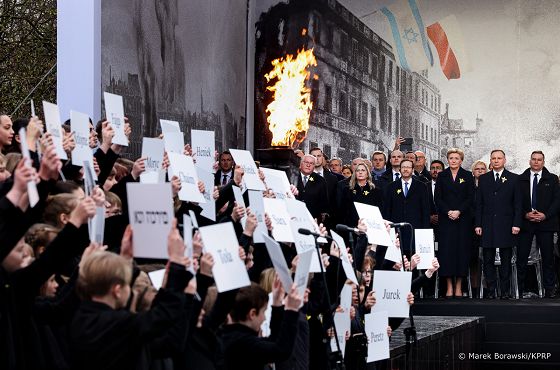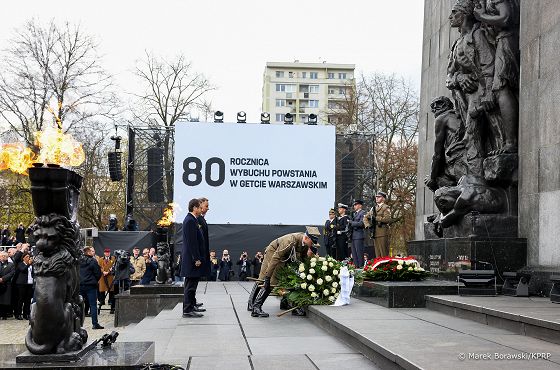
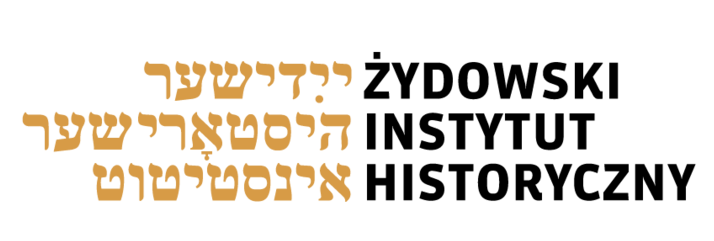 „Najważniejsze jest życie”. Uroczystość z okazji 80. rocznicy wybuchu powstania w getcie warszawskim
„Najważniejsze jest życie”. Uroczystość z okazji 80. rocznicy wybuchu powstania w getcie warszawskim
Natasza Majewska
19 kwietnia 2023 roku minęła 80. rocznica wybuchu powstania w getcie warszawskim. O godzinie 12:00 pod Pomnikiem Bohaterów Getta w Warszawie odbyła się uroczystość ku czci powstańców.
.
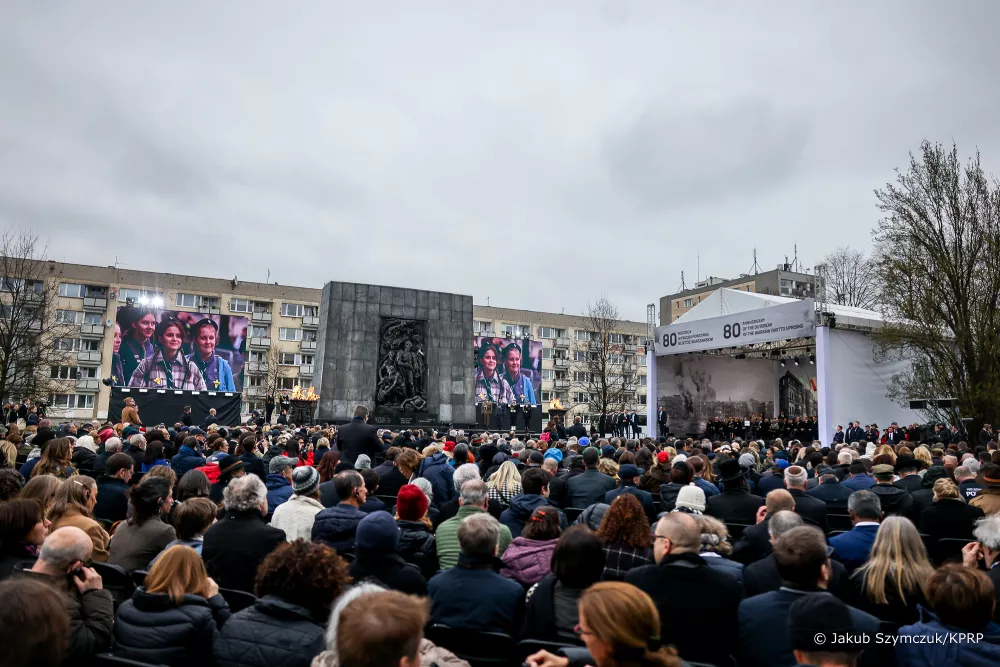 fot. Jakub Szymczuk / KPRP i Marek Borawski / KPRP
fot. Jakub Szymczuk / KPRP i Marek Borawski / KPRP
Ceremonia rozpoczęła się od wspólnego odśpiewania polskiego hymnu, po którym przemawiał prof. Marian Turski, ocalały z Zagłady, wiceprzewodniczący Stowarzyszenia ŻIH w Polsce.
– Nasza cywilizacja przyswoiła sobie kilkanaście symboli oporu i bohaterstwa – mówił prof. Turski. – Mam prawo powiedzieć, że przed osiemdziesięciu laty powstańcy z getta przekształcili otaczające tu nas ulice – Gęsią, Miłą, Niską, Muranowską – w żydowskie Termopile, powtórzyli żydowską Masadę, żydowskie Westerplatte. Jeden z dowódców powstania w getcie, Marek Edelman – miałem szczęście znać go, rozmawiałem z nim wielokrotnie – powtarzał często znamienne słowa: najważniejsze jest życie. A gdy się już ma życie, najważniejsza jest wolność i często dla tej wolności znów przychodzi oddawać życie.
Następnie Zespół Reprezentacyjny Miasta Kirjat Mockin „Kowa tembel” z Izraela przygotowany przez Iris Bejt-Halewi Sznajder, Chór Dziecięcego Miasta Łodzi pod dyrekcją Waldemara Sutrykai Chór Artos im. Władysława Skoraczewskiego przy Teatrze Wielkim Operze Narodowej pod dyrekcją Danuty Chmurskiej, zaśpiewały pieśń partyzantów żydowskich Zog nit kejn mol, napisaną w 1943 roku przez wileńskiego poetę Hirsza Glika. Po wysłuchaniu pieśni zabrali głos prezydenci Polski, Izraela, Niemiec oraz Warszawy, a także Ronald Lauder, przewodniczący Światowego Kongresu Żydów.
– Powstańcy getta warszawskiego są niegasnącym przykładem męstwa, bohaterstwa, są symbolem odwagi, godności i męstwa jak lwy. Nigdy o nich nie zapomnimy – mówił prezydent RP Andrzej Duda.
Jicchak Hercog, prezydent Izraela, przywołał słowa Cywii Lubetkin, uczestniczkę powstania w getcie warszawskim:
– „Było jasne, że nie mamy szansy zwyciężyć w przyjętym znaczeniu tego słowa, ale wiedzieliśmy, że ostatecznie to my zwyciężymy – my słabi, w tym była nasza siła, wierzyliśmy w sprawiedliwość, wierzyliśmy w człowieka”. Cywia i jej towarzysze mieli rację – dodał prezydent Hercog. – Większość bojowników powstania w getcie warszawskim nie przeżyła, ale duch ludzki zwyciężył.
Prezydent Republiki Federalnej Niemiec Frank-Walter Steinmeier zacytował w swoim wystąpieniu inną bohaterkę powstania, Rachelę Auerbach, członkinię grupy Oneg Szabat, której listy z warszawskiego getta pod redakcją dr Karoliny Szymaniak z Działu Naukowego ŻIH ukazały się pod koniec 2022 roku w tłumaczeniu na język niemiecki:
– „Żelazną miotłą wymiotą w pierwsze chłodne dni tych, którzy już teraz są na ulicy, którzy wyprzedali się z ciepłej odzieży, a słabi są jak muchy jesienne. Na nic witalność niesłychana warszawskiego Żyda. Krzyczą i bronią się do ostatka, do ostatniej godziny i minuty, ale godzina i minuta ta nadejdzie” – te słowa zapisała w swoim dzienniku Rachela Auerbach, która sama zmuszona była żyć w getcie. Ile bólu tkwi w tych kilku zdaniach, ile smutku, ale też ile opanowania. Rachela Auerbach wiedziała, że Żydzi Warszawy byli straceni, zapisom jej i innych osób współtworzących archiwum Ringelbluma zawdzięczamy wiedzę o straszliwych zbrodniach popełnionych tu przez nazistów oraz pamięć o świecie, który unicestwili. „Niszczy się miasto i niszczy się naród” – pisze Rachela Auerbach. Wstrząśnięci, czytamy o okrucieństwie, jakiego doświadczyli ludzie za wysokimi murami getta. To jest raport z piekła. Wstrząśnięci, czytamy też o sile, o człowieczeństwie i odwadze, wszystko to wielu zachowało w sobie i nawet miłość była w getcie, jak opowiedział Marek Edelman w tak poruszający sposób. To jest ich przesłanie dla nas: zachować pamięć i przekazywać ją dalej, aby nie powtórzyło się to, co się wydarzyło.
– Szanowny panie przewodniczący Turski – mówił następnie Ronald Lauder, – znamy się od czterdziestu lat, kiedy po raz pierwszy przyłączyłem się do państwa i spotkaliśmy się w Instytucie Żydowskim. Tam przetrzymywane były wszystkie pamiątki o Żydach i rzeczywiście pokazywał pan, że wszystkie te pamiątki powinny zostać zachowane i oddane pod pieczę Instytutu Żydowskiego.
Prezydent Warszawy Rafał Trzaskowski w swoim wystąpieniu zwrócił uwagę na to, jak bardzo integralną częścią Warszawy była i jest jej żydowska społeczność:
– Ta olbrzymia tragedia Holokaustu, tragedia getta warszawskiego to również olbrzymia tragedia Warszawy, mojego, naszego ukochanego miasta. To po prostu wyrwanie części naszego serca. Niemcy wyrwali nam część serca, dokonując tego niesłychanego mordu. Po tym wszystkim, co się stało, nie ma już miejsca w Polsce, w Europie, na świecie na antysemityzm, nie powinno być również miejsca na brak tolerancji.
Następnie rabini i duchowni – katolicki, prawosławny i protestancki – odmówili modlitwę międzyreligijna, po której odczytany został apel pamięci poległych.
Na zakończenie uroczystości nastąpiło złożenie wieńców pod Pomnikiem Bohaterów Getta Warszawskiego. Wieniec od warszawskich organizacji żydowskich złożyła dyrektor ŻIH Monika Krawczyk wraz z dyrektorem Muzeum Getta Warszawskiego Albertem Stankowskim, dyrektorem Muzeum Polin Zygmuntem Stępiński i dyrektorem TSKŻ Arturem Hofmanem.
fot. Jakub Szymczuk / KPRP i Marek Borawski / KPRP
Pełny tekst przemówień rocznicowych:
Zobacz program wydarzeń towarzyszących obchodom 80. rocznicy wybuchu powstania w getcie warszawskim.
Zawartość publikowanych artykułów i materiałów nie reprezentuje poglądów ani opinii Reunion’68,
ani też webmastera Blogu Reunion’68, chyba ze jest to wyraźnie zaznaczone.
Twoje uwagi, linki, własne artykuły lub wiadomości prześlij na adres:
webmaster@reunion68.com

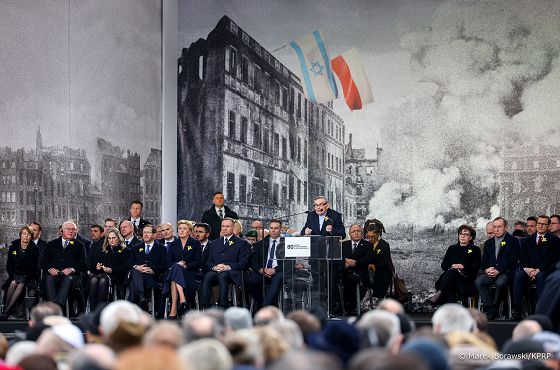 .
.